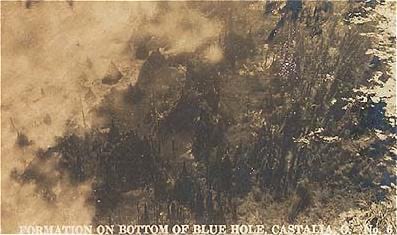
Places that don't exist and the people who live there.
Blue Hole Links  The Buckeye Chronicles
Article: "A Big, Blue Hole," Sandusky Register
EREWHON, the album
Where Nowhere Is
The Buckeye Chronicles
Article: "A Big, Blue Hole," Sandusky Register
EREWHON, the album
Where Nowhere Is

Recollections:
Mike WatrenI was telling my ten year old son about it and decided to check the internet, found that the area has been closed for some time. I wonder what it is like now, is the water as it was the way I remember? Looks like I won't get the chance to see or take my family there to show them what I was amazed to see so long ago. The times have changed so much, everything is at a pace now that we don't take the time to just walk around something and really look at it and let the sights sink in, what a shame.
Craig Bell, Indianapolis, recalls:
Matthew Mohr, Ohio City, recalls:
Two years ago, I was traveling through the area on an afternoon excursion, and tried to visit again. The antique store a few doors down said they had closed it down because they couldn't afford to make the attraction wheelchair accessible. There were "No Trespassing" signs posted. I drove down the driveway despite the warnings, and was afforded a view from afar. The same rickety wooden fence and shelter still stood. I left. There was something hauntingly American about the scene.
I have in my collection of antique photos, a photo-postcard from the Blue Hole, View No. 2. It dates from about 1915 and is an attempt at showing the bottom. It looks like across between a lunar site and a swamp. Very ethereal:

A Big, Blue Hole
by Matt Westerhold
Reprinted with permission, originally published in the Sandusky Register, 1996
Before Columbus came to America, even before the Indians came to this continent - before anyone set foot here - underground streams fed natural fountains, springs of gushing water.
And from those springs, Castalia's Blue Hole came into existence - but not for many years.
The natural springs were so prominent in the area that in 1836 the village was named for the Fons Castalius Fountain near Delphi, Greece.
Undisturbed, the mysterious underground streams and rivers continuously pump out 450,000 gallons of water per hour, every hour, every day, since long before recorded history. That's enough water to meet the water supply demands of nearly the entire present day population of Erie County.
The area surrounding the Blue Hole was known as Junandat of Wyandot Town, when Major Robert Rogers, of the Colonial Rangers, discovered it in 1761. Rogers kept meticulous notes and wrote that year about a remarkable fine spring, the earliest recorded notation about the springs in the area surrounding the present site of the Blue Hole.
In 1810. a pioneer entrepreneur by the name of Dorcastus P. Snow built a grist mill on the site, and build a dam to increase efficiency. Within 10 years, the geological effect of Snow's damming the flow resulted in the creation of the Blue Hole.
As water rushes and rises from the funnel-like shape of the Blue Hole through two outlets, the surface of the water remains calm and unbroken.
The soft sound of the rushing water, opposed to the quiet stillness of the glass-like surface, all set in a quiet forest, may perhaps be what Indian tribes saw as the Holy Essence, a place where the planet feeds itself with an unending flow of mysterious water.
Although Major Rogers is credited with discovering the azure blue springs in the winter of 1761, when he made his discovery, a medicine camp made by the Wyandot Indians was already at the site.
Indians attributed great curative powers to the clear, cold water, which maintains a constant temperature between 48 and 51 degrees.
Perhaps it is those curative powers that protect the Blue Hole and the surrounding area from commercial development.
For nearly 60 years, beginning in the early '30s, the Blue Hole was a tourist attraction - until it closed in 1990. Its claim to fame was twofold: the sparkling waters held no oxygen, and as a result no life, and the Blue hole was said to be bottomless. Efforts to measure its depths were unsuccessful.
But as time passed, tourist dollars more and more were being spent by parents looking for ways to keep their children occupied and happy. And more and more kids were looking for water slides, go-karts and video games.
And the quiet calm over the top of rushing water, unfortunately, did not compete well for those tourist dollars. Ultimately it became fiscally impossible to keep the Blue Hole open for visitors.
Change is always difficult, and the closing of the Blue Hole was a very sad note for many area residents.
Perhaps a blessing in disguise, the change in tourist habits, which led to the closing of the gate, also led the preservation of the area. The quiet fountain escaped the trampling of human consumption.
The owners of the 500 acres on which the Blue Hole sits decided to close the doors rather than face the commercialization of the land necessary to compete.
The years from the early '30s when the owners put up the gate and decided to charge a fee to pay to clean the area after busy weekends, to when it closed in 1990, is but one short frame in the long span of time.
And today, the Blue Hole sits, much as it did a hundred years ago.